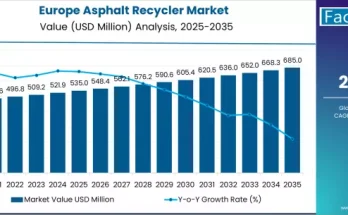The float switch sensor market is witnessing steady expansion as industries increasingly emphasize precision, automation, and safety in fluid level management. Float switch sensors, essential devices for detecting and controlling liquid levels within tanks and containers, play a pivotal role in optimizing processes across industries such as water treatment, oil and gas, food and beverage, chemical manufacturing, and automotive.
As the global demand for efficient fluid control and monitoring systems intensifies, float switch sensors are evolving from basic mechanical devices to intelligent components integrated with automation and IoT technologies. Their adaptability, reliability, and cost-effectiveness are driving widespread adoption across both industrial and commercial applications.
Market Overview
Float switch sensors are designed to detect changes in liquid levels and trigger control actions such as starting or stopping pumps, opening valves, or activating alarms. These sensors operate on simple yet highly reliable mechanical principles — utilizing a buoyant float that moves with liquid level changes — making them indispensable in maintaining operational efficiency and preventing overflow or dry-run conditions.
Over time, technological advancements have enhanced the accuracy and durability of these sensors. Modern float switch sensors now incorporate stainless-steel, polymeric, or corrosion-resistant materials to ensure long-term performance, even in harsh chemical or marine environments. The growing integration of digital monitoring systems and the shift toward smart industrial infrastructure are further reinforcing the relevance of these sensors in automated process industries.
Moreover, as sustainability becomes a core operational objective, industries are relying on float switch sensors to optimize water usage, minimize waste, and ensure environmental compliance. This combination of efficiency, reliability, and eco-friendliness positions the market for continuous growth over the coming decade.
Regional Insights
North America
North America remains a major hub for float switch sensor deployment, supported by the presence of well-established industrial automation sectors and advanced water management infrastructure. The increasing adoption of smart monitoring systems across wastewater treatment facilities, chemical plants, and manufacturing units continues to drive regional growth. Additionally, stringent safety and environmental standards are encouraging industries to adopt high-precision fluid level detection systems.
Europe
Europe is at the forefront of implementing sustainable technologies and energy-efficient solutions. The region’s emphasis on clean water management, renewable energy systems, and advanced manufacturing is accelerating the integration of float switch sensors across various applications. European manufacturers are also focusing on developing eco-friendly and compact sensor designs that align with evolving environmental directives.
Asia-Pacific
Asia-Pacific represents a rapidly growing market, supported by industrial expansion, urbanization, and increased investments in water treatment and manufacturing infrastructure. Emerging economies like China and India are actively adopting automation technologies to streamline production and resource management. The rising demand for efficient monitoring in power generation, oil & gas, and process industries further enhances the region’s growth potential.
Rest of the World
Regions such as Latin America and the Middle East & Africa are witnessing gradual adoption of float switch sensors, primarily in sectors like oil exploration, desalination plants, and water resource management. Infrastructure development projects and industrial diversification are creating favorable conditions for market penetration.
Key Trends & Forecast
- Integration with IoT and Automation Systems
The convergence of IoT and automation technologies is revolutionizing traditional fluid monitoring systems. Float switch sensors are now being connected to cloud-based platforms, enabling real-time data analysis and predictive maintenance capabilities. - Rising Demand for Compact and Durable Designs
Industries are prioritizing compact sensors that offer high precision without compromising durability. Advanced designs incorporating corrosion-resistant materials and miniaturized electronics are gaining traction for use in confined or harsh environments. - Growth in Smart Water and Wastewater Management
The expansion of municipal water treatment plants and the adoption of smart city frameworks are boosting the need for reliable fluid level monitoring systems. Float switch sensors play a critical role in ensuring optimal water distribution and preventing overflows or leaks. - Focus on Energy Efficiency and Sustainability
Manufacturers are developing energy-efficient sensors that align with global sustainability goals. These devices help minimize resource wastage and operational costs while maintaining system reliability. - Emergence of Industry-Specific Solutions
Customization is becoming a key competitive differentiator. Manufacturers are offering float switch sensors tailored to specific applications — such as high-pressure environments in oil refineries, sanitary-grade sensors in food processing, and miniaturized designs for laboratory equipment.
Applications & End-Use Outlook
The versatility of float switch sensors has made them indispensable across numerous industries. Their applications extend beyond industrial use to commercial and residential systems, ensuring safety and operational precision in various liquid-handling processes.
- Water and Wastewater Treatment: Used to control pump operations, prevent tank overflows, and maintain consistent water levels in treatment systems.
- Oil & Gas: Employed for fluid monitoring in storage tanks, drilling rigs, and refineries, where safety and reliability are paramount.
- Chemical & Pharmaceutical Industries: Ensure proper fluid management in reactors, mixing vessels, and chemical storage units, maintaining strict process control.
- Food & Beverage Processing: Used in filling machines, cooling systems, and liquid ingredient management, where hygiene and accuracy are critical.
- HVAC and Building Automation: Integral to monitoring and controlling water flow and coolant systems in heating and ventilation applications.
- Marine and Automotive Sectors: Enable fuel and oil level detection, ensuring optimal engine performance and preventing mechanical failures.
With the expansion of automated control systems and the increasing emphasis on predictive maintenance, float switch sensors are becoming vital components of industrial IoT ecosystems, offering real-time feedback for smarter decision-making.
Challenges and Opportunities
While the float switch sensor market continues to expand, it faces challenges such as calibration errors, mechanical wear, and the need for periodic maintenance. However, ongoing innovation in non-contact sensing technologies, wireless communication modules, and self-cleaning designs is addressing these issues effectively.
Opportunities lie in emerging application areas such as renewable energy systems, biomedical equipment, and smart home devices. Manufacturers are also focusing on providing integrated sensor solutions with modular connectivity features, enabling seamless integration into modern process automation frameworks.
Conclusion
The float switch sensor market is evolving in response to the growing demand for accuracy, automation, and sustainability in fluid management systems. As industries transition toward digitalized and eco-efficient operations, float switch sensors are becoming critical enablers of process control and operational safety.
Their ability to deliver reliable performance across diverse environments ensures their continued relevance in the era of smart manufacturing. Organizations aiming to enhance process efficiency and reduce operational risks are increasingly turning to innovative float switch sensor technologies — a move that is shaping the future of industrial measurement and control systems worldwide.
Browse Full Report – https://www.factmr.com/report/553/float-switch-sensor-market



